How Wind Fences Improve Crop Yields, Reduce Costs, and Protect Agricultural Investments
In many sectors, large amounts of valuable assets are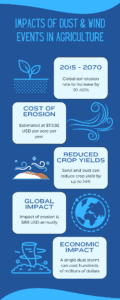 damaged or lost each year due to dust, erosion and other wind-related events. Evidenced by industries increasingly investing in dust and wind suppression strategies to protect assets, maintain productivity and minimize environmental impacts, the global dust control systems market continues to grow, with an estimated value of $16.7B USD in 2023 and projections of $24.5B by 20323. The economic impact of dust and wind has been extensively studied and its influence is far-reaching. With the global soil erosion rate estimated to increase by 30 – 60% from 2015 – 2070,17 strategies to mitigate the detrimental impact of these challenges have reached a critical crossroads.
damaged or lost each year due to dust, erosion and other wind-related events. Evidenced by industries increasingly investing in dust and wind suppression strategies to protect assets, maintain productivity and minimize environmental impacts, the global dust control systems market continues to grow, with an estimated value of $16.7B USD in 2023 and projections of $24.5B by 20323. The economic impact of dust and wind has been extensively studied and its influence is far-reaching. With the global soil erosion rate estimated to increase by 30 – 60% from 2015 – 2070,17 strategies to mitigate the detrimental impact of these challenges have reached a critical crossroads.
Wind, dust and soil erosion negatively affect product yield in a multitude of industries but one of the hardest hit is agriculture/horticulture. In agricultural settings, direct damage to crops due to wind and soil erosion can be devastating, costing local and global economies approximately $113.92USD/acre/year – 75% of which comes directly out of the pocket of farmers18. With this in mind, it is imperative for industry stakeholders to gain insight into management solutions for dust and wind related events with a focus on the solutions available to maintain or increase harvest yields. In this blog we will look at the top 5 financial benefits of wind fences for agricultural applications.
A wind fence, also known as a wind break or wind barrier, is a porous structure that is designed and erected to reduce wind velocity and modify localized wind patterns. They protect product yield on agricultural sites through reduced wind velocity, dust suppression, minimized material loss, improved energy efficiency, and preservation of product quality. For detailed information on how a wind fence works visit our website at www.weathersolve.com or speak with our experts directly at info@weathersolve.com or 1-800-749-2201.
Top 5 Financial Benefits of Wind Fences for Farmers
1. Increased Product Yields Through Wind Reduction
The primary purpose of a wind fence is to reduce wind speed in a designated area and, dependent on the 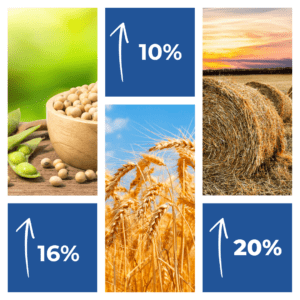 situation, diminish dust. In most cases, a custom wind fence can lower wind velocity upwards of 80% in smaller areas, and 50% over larger areas. In agriculture, this reduction in wind can have a significantly positive effect on plants and livestock alike. In fact, the implementation of a windbreak can improve animal welfare and significantly increase many agricultural crop yields6,7. The list of crops benefitting from reduced wind is extensive with a substantial amount of research conducted on soybeans, hay and wheat 6,8. On average, soybean crops increase by approximately 16% while wheat yields increase by an average of 10%6. According to Utah State University, a wind break can increase some crop yields by a staggering 44%1.
situation, diminish dust. In most cases, a custom wind fence can lower wind velocity upwards of 80% in smaller areas, and 50% over larger areas. In agriculture, this reduction in wind can have a significantly positive effect on plants and livestock alike. In fact, the implementation of a windbreak can improve animal welfare and significantly increase many agricultural crop yields6,7. The list of crops benefitting from reduced wind is extensive with a substantial amount of research conducted on soybeans, hay and wheat 6,8. On average, soybean crops increase by approximately 16% while wheat yields increase by an average of 10%6. According to Utah State University, a wind break can increase some crop yields by a staggering 44%1.
Improved product yield in agriculture often occurs when wind speeds are reduced, thus preventing plant damage and stunted growth while simultaneously helping to retain soil moisture and reduce erosion. Some crops are particularly sensitive to even the slightest wind. New Zealand kiwifruit farmers are no strangers to the damaging effects of wind and weather on their crops. They have learned through experience that exportable kiwifruit harvests can hover close to zero without implementation of proper protective measures such as wind fences. In order to ensure a good crop yield, wind barriers are required to protect the plants from wind which promotes pollination and prevents bruising and damage to fruit15.
Another highly wind sensitive crop is carambola, 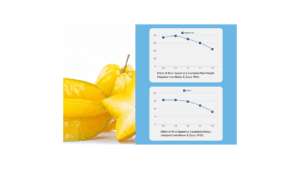 commonly known as star fruit. Studies have shown that carambola growth, leaf area and overall fruit weight is severely impacted by the effects of wind, in some cases temporarily stopping growth altogether21. In fact, many plants stop growing after being vibrated by winds. To observe the effect, try growing two beans in a pot on the window-sill and gently tap one of them on the growing tip once every morning. After a week the tapped one will be noticeably shorter than the other one growing in “calm” conditions.
commonly known as star fruit. Studies have shown that carambola growth, leaf area and overall fruit weight is severely impacted by the effects of wind, in some cases temporarily stopping growth altogether21. In fact, many plants stop growing after being vibrated by winds. To observe the effect, try growing two beans in a pot on the window-sill and gently tap one of them on the growing tip once every morning. After a week the tapped one will be noticeably shorter than the other one growing in “calm” conditions.
The effect of wind on product yields is well established with research demonstrating that the implementation of a wind barrier greatly improves product yield. One such study by Osorio et al in 2019 illustrates the degree to which a wind barrier improves harvest output as illustrated in the graph below.
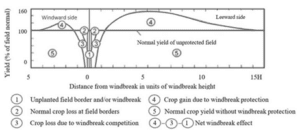
Source: Osorio, R., Barden, C., Ciampitti, I. “GIS approach to estimate windbreak crop yield effects in Kansas-Nebraska” Agroforest System (2019) 93:1569
As it pertains to livestock, wind has been shown to negatively impact animals resulting in undue stress and discomfort precipitating health issues9. Creating a comfortable environment for livestock is associated with an increased rate of weight gain, decreased disease occurrence and improved immune health16. The integration of wind breaks not only provides a shield against the effects of wind leading to happier and healthier animals but can also produce shade. Shade increases milk production in cattle by 10 – 19% and conception rates by 25% compared to cattle without shade29.
2. Reduced Crop Damage Through Dust Suppression
Agricultural sites exposed to dust and dust emissions experience negative impacts on crops, livestock and human health. With the annual average number of “dusty days” consistently trending upward and air particulate matter worsening overall visibility,14 it is more critical than ever to develop and execute dust mitigation strategies in farming to minimize revenue losses and protect assets.
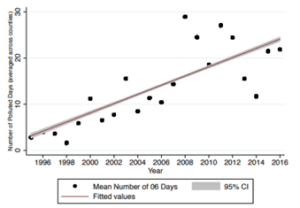
Average number of dusty days across all countries over time
Source:Feriz, M., Yousefi, K. “Dust Emissions and Manufacturing Firm Productivity: Comprehensive Evidence from Iran“
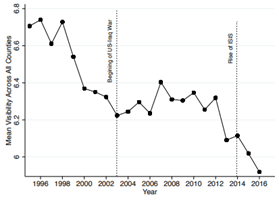
Average visibility across all countries over time
Source: Feriz, M., Yousefi, K. “Dust Emissions and Manufacturing Firm Productivity: Comprehensive Evidence from Iran”
It comes as no surprise that wind and dust storms are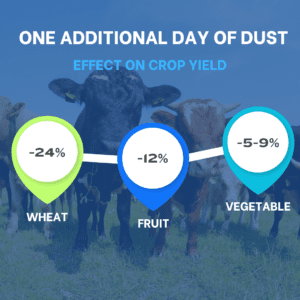 major contributors to soil erosion 22, decreased photosynthesis, germination and loss of plant tissue 23: inherit; Studies estimate that an increase of just one day of dust related events could reduce agricultural productivity by 1.5 – 24% depending on the crop type,23 while Stanford University estimates that clean air contributes to an increase in crop yields worth approximately $5B USD annually24.
major contributors to soil erosion 22, decreased photosynthesis, germination and loss of plant tissue 23: inherit; Studies estimate that an increase of just one day of dust related events could reduce agricultural productivity by 1.5 – 24% depending on the crop type,23 while Stanford University estimates that clean air contributes to an increase in crop yields worth approximately $5B USD annually24.
Custom wind fences consistently reduce dust levels by upto 80% and require little to no maintenance once installed, making them the obvious choice for dust control in the majority of agricultural settings. Not only do they protect plants from damage, they also protect against soil erosion thereby ensuring crop viability for future harvests. The end result is greater crop yields, healthier plants and better profit margins.
3. Minimized Material Damage and Loss From Erosion
Strong winds and storms cause huge losses of materials each year. In the United States, the National Oceanic and Atmospheric Administration reports 27 confirmed weather or climate related events in 2024 exceeding losses of $1B USD each25. With climate change expected to cause increasing numbers and severity of extreme weather events in the coming years, minimizing product damage and loss is of paramount importance. A wind fence protects assets and improves product yield through preventing material displacement, mitigating erosion, and enhancing storage conditions.
Gusts and high winds can cause loose or bulk material such as feed and fertilizer to be displaced or blown away, not to mention the effects on precious top soil. The risk of soil erosion is of particular concern in agricultural settings. Strong winds and weather events erode soil and spread dust which can deplete, damage and even obliterate crops. Consider the severe drought that led to the dust bowl decimating agriculture in the Great Plains and Southern states from 1930 – 1940. One the contributing factors to this catastrophe was identified as poor soil conservation26. Approximately 1.2 billion tonnes of top soil was lost due to erosion – upwards of 75% in some regions26. This event sparked intensive research into the use of wind barriers to protect soil and minimize the negative implications of wind and dust on crops. It was determined that wind fences significantly improve soil conditions and suppress dust resulting in better crop yields and reduced erosion making them a go to in agricultural settings.
Wind fences can also be designed to create sheltered areas for the storage of materials that are susceptible to wind damage such as raw powdered materials and fertilizers. Improved storage conditions minimize material degradation and loss, preventing inventory and profits from literally blowing away in the wind.
4. Reduced Energy Costs Through Wind Reduction
The high costs of energy consumption are particularly prevalent in greenhouse farming and those in the industry are keen to implement measures to conserve energy especially during hot summers and cold winters. Wind is an omnipresent energy sucker in greenhouse operations where a wind of 15mph can double heat loss during the winter months27. Temperature regulation of greenhouses is estimated to be 50-80% of total operating costs27 and doubling energy costs clearly has severe financial implications.
When custom wind fences are strategically placed around greenhouses, they act not only as wind breakers, but also insulators. Wind reduces the insulating effectiveness of the boundary layer that occurs along greenhouse glazing27 exacerbating temperature extremes. Wind barriers have demonstrated protection from extreme summer heat and freezing winter winds while keeping your hard-earned money in your pocket. Their ability to act as a shield against incoming winds has been shown to reduce winter heating costs by 20-40%1 on average.
5. Optimized Crops & Moisture Retention Through Microclimate Stabilization
Wind fences play an integral role in the regulation of microclimates in agriculture. Evaporation rates, poor snow distribution and fluctuating temperatures lead to poor crop yields, nutrient depleted soil and reduced soil moisture management. In colder climates, wind fences encourage moisture retention by more evenly distributing snow and thereby increasing the amount of available moisture post thaw reducing irrigation needs and benefitting crop growth. With improved temperature regulation, the quality and yield of crops and livestock is improved through reduced stress and damage.
Key Points
Wind fences offer significant financial benefits for the agricultural industry through crop protection, improved yields and livestock preservation. By reducing wind speeds and dust levels, these barriers minimize material loss and improve soil health ensuring that farmers and other industry stakeholders can maintain or increase their product yields and profit margins. As climate change continues to exacerbate and cause severe weather events, investing in wind fences represents a pro-active solution for safeguarding agricultural productivity and profitability. The long-terms benefits of implementation far outweigh the initial investment, making wind fences a smart and essential tool for farmers aiming to survive in an unpredictable environment.
References & Additional Reading Materials:
- Windbreak Benefits and Design 005 – Windbreak Benefits and Design | Fact Sheets | Publications | Forestry | Extension | USU Accessed August 26, 2024
- Schuldt, S., Nicholson, M., Adams, Y., et al. Weather-Related Construction Delays in a Changing Climate: A Systematic State-of-the-Art Review. Weather-related Construction Delays in a Changing Climate: A Systematic State-of-the-art Review (afit.edu) Accessed August 26, 2024
- WMO “Global Assessment of Sand and Dust Storms” 2016 https://catalogue.unccd.int/765_Global_assessment_sand_dust_storms_2016.pdf Accessed Dec 19, 2024
- Evans, D., “Quantification of Airborne Dusts From Powders.” NIOSH Manual of Analytical Methods (NMAM), 5th AD-61.
- UNCCD “Sand and Dust Storms Compendium” Chapter 6 Economic Impact Assessment Framework. Pp 163.
- Osorio, R., Barden, C., Ciampitti, I. “GIS approach to estimate windbreak crop yield effects in Kansas-Nebraska” Agroforest System (2019) 93:1567-1576
- Grace, J. “Plant Response to Wind” Department of Forestry and Natural Resources University of Edinburgh. (1977) pp 36-40.
- USDA “Can Windbreaks Increase Crop Yields” National Agroforestry Center First Edition August 2023
- Agriculture Canada “ Snow and Wind Control for Farmstead and Feedlot” 1981.
- “Powermag” 12/01/2016 on results from Endesa Power Stn Spain https://www.powermag.com/who-moved-my-btus-the-pitfalls-of-extended-coal-storage/ Accessed Sept 16, 2024
- Government of Canada – EPA “Recommended Best Practices” https://www.canada.ca/en/environment-climate-change/services/canadian-environmental-protection-act-registry/historical/public-consultations/code-practice-reduce-fugitive-emissions-total-particulate-matter-volatile-organic-compounds-iron-steel-ilmenite-sector/recommended-best-practices.html Accessed Dec 24, 2024
- Katestone Environmental Pty “Environmental Improvement Program – Particulate Matter Control Best Practice Study” June 2017
- Al-Hemoud, A., Misak, R. , Al-Sudairawi et al. “Economic Impact and Risk Assessment of Sand and Dust Storms (SDS) on the Oil and Gas Industry in Kuwait” Sustainability 2019, 11(1), 200; https://doi.org/10.3390/su11010200
- Feriz, M., Yousefi, K. “Dust Emissions and Manufacturing Firm Productivity: Comprehensive Evidence from Iran” https://econ.cam.ac.uk/people-files/faculty/km418/IIEA/IIEA_2018_Conference/Papers/Birjandi-Feriz_Dust%20Emissions%20and%20Manufacturing%20Firm%20Productivity;%20Comprehensive%20Evidence%20from%20Iran.pdf Accessed Jan 6, 2025
- New Zealand Kiwi Growers “Chapter 3: On-Orchard Management Practices”
- Lily N Edwards-Callaway, M Caitlin Cramer, Caitlin N Cadaret, Elizabeth J Bigler, Terry E Engle, John J Wagner, Daniel L Clark, Impacts of shade on cattle well-being in the beef supply chain, Journal of Animal Science, Volume 99, Issue 2, February 2021, skaa375, https://doi.org/10.1093/jas/skaa375
- European Commission Joint Research Centre “Soil Erosion by water could lead to a global loss of up to USD 625 billion by 2070” February 9, 2024. https://joint-research-centre.ec.europa.eu/jrc-news-and-updates/soil-erosion-water-could-lead-global-loss-usd-625-billion-2070-2024-02-09_en Accessed January 23, 2025
- Ruppert, S., Coppess, J., Fathauer, et al. “A Menace to National Welfare Reconsidered, Part 1: Reviewing the Cost of Erosion” Department of Agricultural and Consumer Economics. University of Illinois. March 14, 2024 farmdoc daily (14):52
- Stephenson, A., “Alberta farmers face growing risk of soil erosion in 2024 as drought persists” The Canadian Press January 22, 2024 https://www.cbc.ca/news/canada/calgary/alberta-drought-farm-erosion-risk-2024-season-1.7090899 Accessed January 23, 2025
- Food & Agriculture Organization of the United Nations “Sand and Dust Storms” https://www.fao.org/land-water/land/sds/en/ Accessed January 23, 2025
- Marler, T., Zozor, Y., “Carambola Growth and Leaf Gas-exchange Responses to Seismic or Wind Stress” Horticultural Science 27(8): 913-915 1992.
- Middleton, N., “Impacts of dust storms on agriculture: A synthesis” E3S Web of Conferences, 575, 05001 (2024) https://doi.org/10.1051/e3sconf/202457505001 Accessed January 27, 2025
- Ahmadzai, H., Malhotra, A., Tutundjian, S., “Assessing the impact of sand and dust storm on agriculture: Empirical evidence from Mongolia” PLoS ONE 18(2): e0269270 https://doi.org/10.1371/journal.pone.0269271 Accessed January 27, 2025
- Stanford Report. “Cleaner air has boosted U.S. corn and soybean yields, Stanford-led research shows.” July 1, 2021. https://news.stanford.edu/stories/2021/07/clean-air-boosts-crop-yields Accessed January 27, 2025.
- NOAA “Billion-Dollar Weather and Climate Disasters” https://www.ncei.noaa.gov/access/billions/ Accessed January 27, 2025
- “Dust Bowl” https://www.britannica.com/place/Dust-Bowl Accessed January 27, 2025.
- Roraburgh, P., Jensen, M., Giacomelli, G. “Introduction to Controlled Envrionment Agriculture and Hydroponics” Controlled Environment Agriculture Center University of Arizona. Fall 2002.
- University of Missouri Center for Agroforestry. “Chapter 6: Windbreaks” 2021 Edition.
- Higgins, S., Agouridis, C., Wightman, S., “Shade Options for Grazing Cattle” Department of Biosystems and Agricultural Engineering Cooperative Extension Service.

Claire Cowie is a seasoned Quality Assurance Manager with over two decades of experience in healthcare and manufacturing. Her career began in pharmacy, where she led teams and honed her skills in quality management systems. As she transitioned to the manufacturing sector, her unique background combines a deep understanding of policy and quality assurance with a keen eye for quality control.
Claire has been instrumental in implementing and cultivating a comprehensive quality control program within WeatherSolve Structures. She has successfully integrated her pharmaceutical background with manufacturing best practices, particularly in areas such as Good Manufacturing Practices (GMP) and ISO 9001 standards. Her unique blend of experience continues to drive innovation and excellence in her role.
